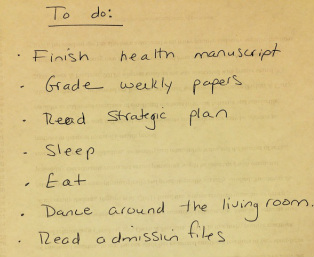We have a range of people in the writing challenge. They are writing journal articles, books, or dissertations. Their goal for the year ranges from 200 to 1100 hours. And there’s a range of work and family circumstances as well. I enjoy checking in to see how others are doing, and see others adding minutes to their cells every week.
In terms of how it’s going for me… I have been scheduling writing on my calendar every weekday. And because I am incredibly pedantic, during my writing time, I set the timer on my cell phone to make sure I really am meeting my goal for that day. The most effective part of setting the timer is that I make myself turn it off if I start the writing task. Pause to check email? Timer is paused. Someone pops in my office? Timer paused. “One hour” of writing can often include many stops and starts with email checks, social media checks, food breaks, etc. But when I time it, I’m much less compelled to do something else (an hour is an hour – it won’t be less time writing if I pause to check email), and I really cram a lot into an hour of scheduled writing time.
There have been exception days. Sometimes things come up in the middle of the day that pull me away from the block of writing time on my calendar. It seems that half of January has involved 2 hour delays at the elementary school. I try to make it up that night, if possible. If not, I carve out some weekend time.
These strategies have been successful so far. In January, I managed a 13 day turnaround, start to finish, on an R&R (they required 2 weeks so the 13 days wasn’t out of sheer motivation). On another R&R I’ve been sitting on, I went from start to e-mailed to co-authors. And for the issue my former student and I are editing, we mailed the full package of 6 chapters to the editor, which involved a fair bit of work in January. So I feel good about my January progress, and hope to keep it up in the coming months that involve more travel and other pulls.
How is it going for others? If you are perfectly on track, you should be at 8.33% of your annual writing goal at midnight tonight. Of course, there might be exceptions, like if you do most of your work on the weekends, or you knew that January was going to be bumpy but upcoming months will be better, etc. On the other hand, resolutions are often their most robust in January, so if January didn’t go well, it may be time to reevaluate your strategies for finding writing time, and/or your goal for the year, to make sure you are being realistic. Or, if your goal has been really easy, perhaps you need to increase your goal.
One person in the writing challenge said that she likes looking at others’ percentage of goal column, and if someone surges ahead of her, she is motivated to get more writing done. I confess I have a similarly competitive spirit, which is why, for instance, I prefer group exercise over individual exercise. Being around others engaged in the same activity motivates me to try harder. Though this competitive spirit is also what led me to hurt my knee in yoga. The teacher was doing a pose and I had the following internal monologue: “That would hurt my knee. But if I don’t do it, other people might think I can’t do it. Ow.”
If you’re not in the writing challenge, how has January been for your current goals and resolutions? And if you want to join now, let me know, and you can join and adjust your hours accordingly.
“The post 2014 Writing Challenge: 1 month check in first appeared on Eva Lefkowitz’s blog on Janauary 31, 2014.”



 RSS Feed
RSS Feed
